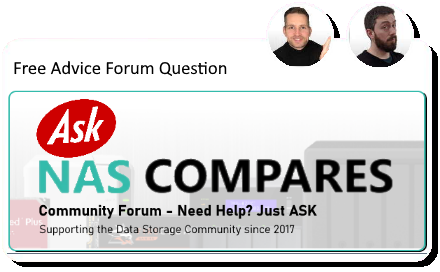07-25-2025, 07:59 AM
The QNAP TS-873A-8G is a strong choice for business use and should meet most of your requirements, especially with the right setup.
Here’s a breakdown:
• 100 simultaneous accesses for file transfers (PDF, Excel, Word, photos, videos):
The TS-873A with its Ryzen V1500B processor and 8GB RAM is capable of handling many concurrent connections, especially for typical office workloads. However, 100 users is a high number. If all 100 are active at once, especially with large files or video content, you may need to upgrade to 16GB RAM and consider SSD cache or higher-performance drives.
• File sharing and syncing (NetBak, Qsync, HBS3):
This unit supports all those services well. The performance of sync operations depends on the type of storage pool, disk speed, and network configuration.
• Video editing (1080p over the network):
The system can handle 1080p editing across a LAN, but keep in mind that HDDs in RAID 1 may become a bottleneck for real-time editing depending on how heavy the editing workload is. If multiple users will be editing or accessing large files at the same time, SSDs or NVMe cache would help.
• Transferring 3GB+ files:
Yes, the NAS can handle that easily — the speed will depend mostly on your network setup and drive performance.
• 125MB/s transfer rate with 2x IronWolf HDDs in RAID 1:
In ideal conditions (sequential transfer, local network with Gigabit or 2.5GbE), yes, two IronWolf drives can deliver ~125MB/s in RAID 1. However, in real-world multitasking or fragmented reads/writes, speeds may drop. NVMe cache is not required, but it will help in maintaining consistent performance if the NAS is under heavy use or during burst transfers.
Here’s a breakdown:
• 100 simultaneous accesses for file transfers (PDF, Excel, Word, photos, videos):
The TS-873A with its Ryzen V1500B processor and 8GB RAM is capable of handling many concurrent connections, especially for typical office workloads. However, 100 users is a high number. If all 100 are active at once, especially with large files or video content, you may need to upgrade to 16GB RAM and consider SSD cache or higher-performance drives.
• File sharing and syncing (NetBak, Qsync, HBS3):
This unit supports all those services well. The performance of sync operations depends on the type of storage pool, disk speed, and network configuration.
• Video editing (1080p over the network):
The system can handle 1080p editing across a LAN, but keep in mind that HDDs in RAID 1 may become a bottleneck for real-time editing depending on how heavy the editing workload is. If multiple users will be editing or accessing large files at the same time, SSDs or NVMe cache would help.
• Transferring 3GB+ files:
Yes, the NAS can handle that easily — the speed will depend mostly on your network setup and drive performance.
• 125MB/s transfer rate with 2x IronWolf HDDs in RAID 1:
In ideal conditions (sequential transfer, local network with Gigabit or 2.5GbE), yes, two IronWolf drives can deliver ~125MB/s in RAID 1. However, in real-world multitasking or fragmented reads/writes, speeds may drop. NVMe cache is not required, but it will help in maintaining consistent performance if the NAS is under heavy use or during burst transfers.





